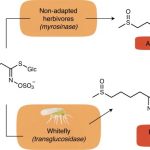Plant Science Research Weekly: October 23, 2020
Perspective: Multiplying the efficiency and impact of biofortification through metabolic engineering

As heterotrophs, we are what we eat. One of the UN Sustainable Development Goals is to end all forms of hunger, including the “hidden hunger” that results from nutrient deficiencies. Van Der Straeten et al. provide an overview of biofortification strategies. They review current successes from conventional breeding, which include: zinc rice, wheat, and maize; provitamin A maize and cassava; and iron beans and pearl millet. However, in some cases, the crop’s genetic diversity is insufficient to achieve meaningful biofortification through traditional methods, and in these circumstances a genetic metabolic engineering approach might be helpful. Golden rice, in which provitamin A is produced in the grain, is only obtainable by genetic engineering because the necessary genes are not naturally expressed in this tissue. Genetic engineering can also make it much more feasible to biofortify for multiple nutrients at the same time by placing the corresponding genes into a single locus, as has enabled the production of polished rice enriched simultaneously for iron, zinc, and provitamin A. As the authors observe, there are several obstacles that must be overcome to accelerate the progress of biofortification. These include updating regulatory frameworks, informing the public about the safety of genetic engineering, obtaining humanitarian licenses for needed technologies, and additional research. (Summary by Mary Williams @PlantTeaching) Nature Comms. 10.1038/s41467-020-19020-4
Perspective. Plant awareness disparity: A case for renaming plant blindness

If there is one thing we agree on, it is that plants are underappreciated, leading to consequences spanning from ecosystem collapse to poor rates of funding. This effect, and efforts to remedy it, have been discussed in terms of “plant blindness”. In this Perspective, Parsley summarizes many of these proposed remedies and their impacts, but more importantly she addresses the growing realization that “plant blindness” is an inappropriate term for this very important concern. “Plant blindness” is “a metaphor that is insensitive to, and exclusive toward, members of the disabled community” and as such it contributes to ableism. Ableism “refers to the idea that disability is somehow inherently bad, when in practice, ableism devalues disabled people.” She instead proposes the term “plant awareness disparity”, which highlights that the root of the problem is the relative lack of awareness of plants and their roles in the world, and also that this problem is resolvable through education. (Summary by Mary Williams @PlantTeaching) Plants People Planet 10.1002/ppp3.10153
Review. The soil-borne identity and microbiome-assisted agriculture: Looking back to the future
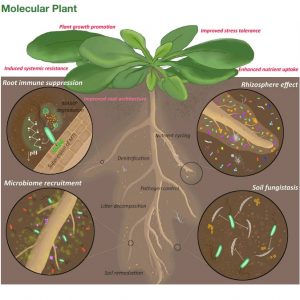 Bakker et al. begin their review of plant-soil microbiome concepts with a Lorentz Hiltner quote from 1904: “However, I am convinced that soil bacteriology will finally provide results that are not only of explanatory nature, but will also directly affect and determine agricultural practice… I would like to state from the very first, that… the main goal of our joint effort to make the results applicable in practice, has not been reached so far.” Since the time of this quote, huge technological and informational developments have emerged within plant science and microbiology that are reviewed here. The review cheekily draws on films from the famous Jason Bourne series: “Legacy,” how proper establishment of a rhizosphere can influence the success of future plant generations; “Supremacy,” how a host plant’s genotype can shape the composition of its rhizosphere’s microbial community and, in turn, the structure and fitness of the host plant; and finally, “Identity,” identifying the specific individuals within the rhizosphere’s microbial community, in relation to different host plants. Whilst acknowledging recent developments, the authors nonetheless assert that: “Asking relevant questions is the main driver of science… It is tempting to perform an analysis just because we can, but techniques alone should not be leading the direction of research questions. […] Lorentz Hiltner would probably be amazed by the progress we have made regarding the detailed information generated over the last century, but many of the questions that he and many scientists after him asked still remain unanswered fully.” As these questions have trenchant stakes within contemporary agriculture’s roles toward global human health and climate change, the authors optimistically conclude that in answering such questions, microbiome-assisted agriculture will flourish in the future. (Summary by Benjamin Jin) Molecular Plant 10.1016/j.molp.2020.09.017
Bakker et al. begin their review of plant-soil microbiome concepts with a Lorentz Hiltner quote from 1904: “However, I am convinced that soil bacteriology will finally provide results that are not only of explanatory nature, but will also directly affect and determine agricultural practice… I would like to state from the very first, that… the main goal of our joint effort to make the results applicable in practice, has not been reached so far.” Since the time of this quote, huge technological and informational developments have emerged within plant science and microbiology that are reviewed here. The review cheekily draws on films from the famous Jason Bourne series: “Legacy,” how proper establishment of a rhizosphere can influence the success of future plant generations; “Supremacy,” how a host plant’s genotype can shape the composition of its rhizosphere’s microbial community and, in turn, the structure and fitness of the host plant; and finally, “Identity,” identifying the specific individuals within the rhizosphere’s microbial community, in relation to different host plants. Whilst acknowledging recent developments, the authors nonetheless assert that: “Asking relevant questions is the main driver of science… It is tempting to perform an analysis just because we can, but techniques alone should not be leading the direction of research questions. […] Lorentz Hiltner would probably be amazed by the progress we have made regarding the detailed information generated over the last century, but many of the questions that he and many scientists after him asked still remain unanswered fully.” As these questions have trenchant stakes within contemporary agriculture’s roles toward global human health and climate change, the authors optimistically conclude that in answering such questions, microbiome-assisted agriculture will flourish in the future. (Summary by Benjamin Jin) Molecular Plant 10.1016/j.molp.2020.09.017
Review: Coumarin communication along the microbiome-root-shoot axis
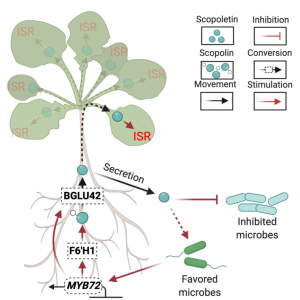 As the realm of microbiology expands, we see increasing ways in which eukaryotes depend on their microbiomes. For instance, in animals, the “microbiome-gut-brain axis” connects gut microbiota and the nervous system and influences a range of activities from digestion to mental health. Stassen et al. build a parallel to plants, defining the “microbiome-root-shoot axis” in which plants produce microbially-induced phytocompounds to communicate and signal for certain actions. Examples of such phytocompounds include strigolactones, which recruit fungi to aid in phosphate uptake, and flavonoids, that mediate legume-Rhizobium relationships. The authors, however, focus on coumarins, established antimicrobial compounds that also take part in nutrient uptake and root-microbiome communication. Genetic studies reveal that genes mediating coumarin biosynthesis and secretion are responsive to iron deficiency and are important for plant survival in iron-deficient soils. Coumarins and coumarin-associated genes also seem to play roles in root-microbiome and microbiome-root communication, shaping rhizosphere composition and priming host plants for immune response, as well as root-shoot communication. The authors conclude with a parallel to the animal central nervous system, noting that future experiments regarding coumarin functions “should aim to elucidate how these root-derived ‘neurotransmitters’ affect the aboveground plant ‘brain’ to ultimately exploit the function of the ‘inverted gut’ microbiota and achieve optimal plant fitness.’” (Summary by Benjamin Jin) Trends Plant Sci. 10.1016/j.tplants.2020.09.008
As the realm of microbiology expands, we see increasing ways in which eukaryotes depend on their microbiomes. For instance, in animals, the “microbiome-gut-brain axis” connects gut microbiota and the nervous system and influences a range of activities from digestion to mental health. Stassen et al. build a parallel to plants, defining the “microbiome-root-shoot axis” in which plants produce microbially-induced phytocompounds to communicate and signal for certain actions. Examples of such phytocompounds include strigolactones, which recruit fungi to aid in phosphate uptake, and flavonoids, that mediate legume-Rhizobium relationships. The authors, however, focus on coumarins, established antimicrobial compounds that also take part in nutrient uptake and root-microbiome communication. Genetic studies reveal that genes mediating coumarin biosynthesis and secretion are responsive to iron deficiency and are important for plant survival in iron-deficient soils. Coumarins and coumarin-associated genes also seem to play roles in root-microbiome and microbiome-root communication, shaping rhizosphere composition and priming host plants for immune response, as well as root-shoot communication. The authors conclude with a parallel to the animal central nervous system, noting that future experiments regarding coumarin functions “should aim to elucidate how these root-derived ‘neurotransmitters’ affect the aboveground plant ‘brain’ to ultimately exploit the function of the ‘inverted gut’ microbiota and achieve optimal plant fitness.’” (Summary by Benjamin Jin) Trends Plant Sci. 10.1016/j.tplants.2020.09.008
A cis-regulatory atlas in maize at single-cell resolution

Cis-regulatory elements (CREs) are DNA sequences found near or within genic regions that drive proper gene expression in time and space. Thus, CREs play essential roles in the diversification of spatially distinct cell-types with specialized function in multicellular organisms. To identify CREs underlying the specification of different organs in the crop species Zea mays (maize), Marand and colleagues improved a protocol for single-cell sequencing of Assay for Transposase Accessible Chromatin (scATAC-seq). By optimizing a method to group nuclei with similar patterns of chromatin accessibility, they identified 10 clusters composed of nuclei from the same organ and 92 sub-clusters associated with 165,913 Accessible Chromatin Regions (ACRs) and 52 known cell-types. Validation of the mRNA spatio-temporal distribution of selected genes by in situ hybridization supports the use of ACRs to predict gene expression. The authors found an association between cluster-specific ACRs and enhancer activity. Interestingly, almost half of the ACRs located in distal regions, and a great proportion overlapped with transposable elements – including the enhancer of the domestication gene teosinte branched1. These findings reinforce the functional importance of transposons in the evolution of CREs within accessible chromatin, which has contributed to phenotypic variation in maize. The authors also demonstrated that the selection of agronomic traits related to inflorescence architecture has targeted polymorphisms of ACRs specific for floral cells. Furthermore, they used ACRs and transcription factors binding sites to predict cell-type identity and function based on the dynamics of chromatin accessibility. The authors envision this comprehensive framework as valuable tool for crop genetic improvement through genome editing and synthetic biology. (Summary and image adaptation by Michela Osnato @michela_osnato) bioRxiv 10.1101/2020.09.27.315499
How to go quiet: CHT7 regulates cell cycle exit in Chlamydomonas
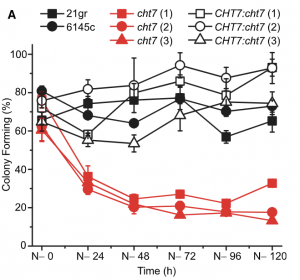 Many microbes enter a state of low metabolic activity, called quiescence, when the conditions for growth and division become unfavorable. The transition from active proliferation to quiescence involves a comprehensive restructuring of cellular metabolism, accumulation of storage compounds, and an orderly exit from the cell cycle. This kind of proliferation-to-quiescence switch has been extensively studied in Chlamydomonas cells that are starved for nitrogen. However, the emphasis in these studies has often been on the starvation-induced accumulation of lipid-based storage compounds, due to their potential industrial uses. Here, Takeuchi et al. instead shift the focus by investigating how the cells cease dividing and exit the cell cycle when nitrogen starts to run out. They show that in the absence of the protein CHT7, the cells keep on dividing and, as a result, rapidly loose viability when nitrogen is withdrawn. Genetically, CHT7 acts as a transcriptional repressor of a broad range of core cell cycle genes in response to nitrogen stress. The underlying mechanism is still an open question, however, and CHT7 itself appears not to bind DNA directly. This study provides a solid foundation for further investigations of the CHT7 pathway, and the coordination between proliferation and quiescence in photosynthetic eukaryotes. (Summary by Frej Tulin @FrejTulin) Plant Cell 10.1105/tpc.19.00628
Many microbes enter a state of low metabolic activity, called quiescence, when the conditions for growth and division become unfavorable. The transition from active proliferation to quiescence involves a comprehensive restructuring of cellular metabolism, accumulation of storage compounds, and an orderly exit from the cell cycle. This kind of proliferation-to-quiescence switch has been extensively studied in Chlamydomonas cells that are starved for nitrogen. However, the emphasis in these studies has often been on the starvation-induced accumulation of lipid-based storage compounds, due to their potential industrial uses. Here, Takeuchi et al. instead shift the focus by investigating how the cells cease dividing and exit the cell cycle when nitrogen starts to run out. They show that in the absence of the protein CHT7, the cells keep on dividing and, as a result, rapidly loose viability when nitrogen is withdrawn. Genetically, CHT7 acts as a transcriptional repressor of a broad range of core cell cycle genes in response to nitrogen stress. The underlying mechanism is still an open question, however, and CHT7 itself appears not to bind DNA directly. This study provides a solid foundation for further investigations of the CHT7 pathway, and the coordination between proliferation and quiescence in photosynthetic eukaryotes. (Summary by Frej Tulin @FrejTulin) Plant Cell 10.1105/tpc.19.00628
Go polar: Regulation of Rho GTPases by ARO proteins
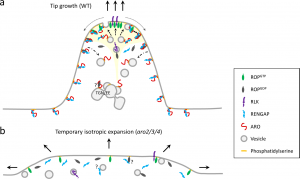
Polar cell growth is a key feature in plant organs like root hairs, trichomes and pollen tubes. Kulich and co-workers have identified novel regulatory elements governing the polar growth of root hairs and trichomes in Arabidopsis thaliana. Studying a group of proteins named ARMADILLO REPEAT ONLY (ARO), the authors found them to specifically localize to and be essential for the growth of polar ends of root hairs and leaf trichomes. Redundancy in function of multiple AROs was evident, as only the double and triple mutants displayed severe phenotypes. Analyzing potential interactors of AROs, the authors found them to redundantly interact with another group of proteins known as RENGAPs (RENs), which are known regulators of Rho of plant (ROP) GTPases. Further analyses showed AROs to interact with RENs as well as GTP-bound, active ROPs, and also that AROs are essential for the localization of RENs and ROPs to polar ends to ensure polar growth of root hairs. Thus, this study highlights a group of proteins that act as central regulators in driving polar growth of plant cells. (Summary by Pavithran Narayanan @pavi_narayanan) Nature Plants 10.1038/s41477-020-00781-1
Opposing, polarity-driven nuclear migrations underpin asymmetric divisions in stomatal patterning
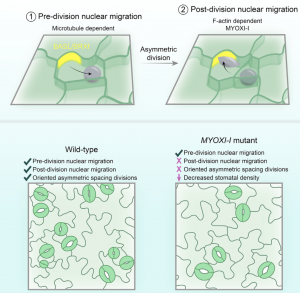 Asymmetric cell divisions (ACDs) are often used by organisms to generate different cell sizes, each adopting a different cell fate. In plants, stomatal development provides an example of an ACD-derived patterning mechanism. Several proteins are known to be implicated in ACDs, like BREAKING OF ASYMMETRY IN THE STOMATAL LINEAGE (BASL) and BREVIS RADIX family (BRXf), which form a polar crescent in the plasma membrane. In this paper Muroyama et al. identified nuclear migration in response to the polarity proteins as an underlying mechanism for the ACD. Using time lapse imaging, the authors identified two nuclear migration events preceding (NMpre) and following (NMpost) the ACD with respect to the polarity proteins BASL and BRXf. These nuclear migrations were lost in the BASL mutant and also in the absence of the polarity crescent. The authors also observed that NMpre and NMpost require microtubules and F-actin respectively and myosin protein (MYOXI-I) is required for the NMpost. Loss of MYOXI-I prevents the NMpost and oriented cell division in stomatal patterning. Summary By (Vijaya Batthula @Vijaya_Batthula) Curr. Biol. 10.1016/j.cub.2020.08.100
Asymmetric cell divisions (ACDs) are often used by organisms to generate different cell sizes, each adopting a different cell fate. In plants, stomatal development provides an example of an ACD-derived patterning mechanism. Several proteins are known to be implicated in ACDs, like BREAKING OF ASYMMETRY IN THE STOMATAL LINEAGE (BASL) and BREVIS RADIX family (BRXf), which form a polar crescent in the plasma membrane. In this paper Muroyama et al. identified nuclear migration in response to the polarity proteins as an underlying mechanism for the ACD. Using time lapse imaging, the authors identified two nuclear migration events preceding (NMpre) and following (NMpost) the ACD with respect to the polarity proteins BASL and BRXf. These nuclear migrations were lost in the BASL mutant and also in the absence of the polarity crescent. The authors also observed that NMpre and NMpost require microtubules and F-actin respectively and myosin protein (MYOXI-I) is required for the NMpost. Loss of MYOXI-I prevents the NMpost and oriented cell division in stomatal patterning. Summary By (Vijaya Batthula @Vijaya_Batthula) Curr. Biol. 10.1016/j.cub.2020.08.100
Calcium dynamics during trap closure visualized in transgenic Venus flytrap
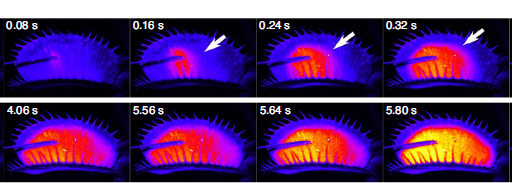
For centuries, carnivorous plants and the mechanisms they use to capture prey have been enigmas. While some clarity regarding the molecular mechanisms is beginning to emerge, Suda and colleagues have uncovered a vital role for calcium (Ca2+) signals in trap closure in Venus flytrap. The researchers introduced the genetically encoded Ca2+ sensor GCaMP6f using an excised-leaf transformation protocol and traced Ca2+ signals during leaf stimulation. They found Ca2+ waves in the leaves after mechanical stimulation of a sensory hair, which extended through the leaf blade to other sensory hairs and the other leaf lobe. The authors also found that after a second stimulus, the Ca2+ signal is higher in intensity and that it is needed for leaf closure, consistent with a ‘memory’ mechanism. Further, they established a threshold Ca2+ concentration that is needed for leaf closure and is achieved only after the second stimulus. These findings provide invaluable clues as to how the plant remembers and amplifies a signal to reach a threshold level and effect the leaf movement. (Summary by Pavithran Narayanan @pavi_narayanan) Nature Plants 10.1038/s41477-020-00773-1
Glucosylation prevents plant defense activation in phloem-feeding insects
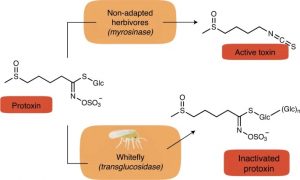
Brassicas produce specialized metabolites called glucosinolates that can be enzymatically converted to release toxic compounds. The catalyzing enzyme is stored in a separate subcellular compartment, so upon wounding by a herbivore the enzyme and substrate mix and release the toxin. Phloem-feeding insects insert a slender stylet into plant tissues, which has been assumed to avoid mixing the enzyme and substrate and to be a reason that these stylet-feeders are less affected by the defensive compounds. Here, Malka et al. show that in fact the phloem feeding insects have a distinct, chemical defense mechanism. The authors found that these insects chemically modify the protoxin glucosinolates through the addition of glucose residues. This reaction is catalyzed by glycoside hydrolases, which are abundant in phloem-feeding insects. This study shows a novel means by which insects can evade plant defenses, and reveals a potential target through which to control these damaging pests. (Summary by Mary Williams @PlantTeaching) Nature Chem. Biol. 10.1038/s41589-020-00658-6



